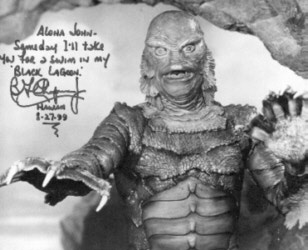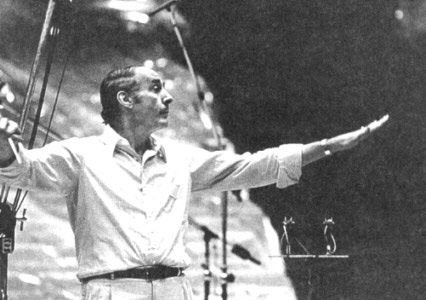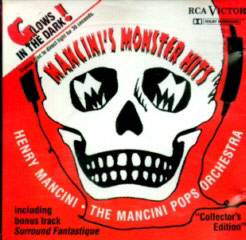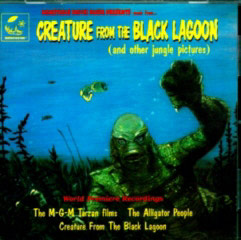HENRY MANCINI - THE COMPOSER FROM THE BLACK LAGOON
By JOHN STANLEY
"The Creature From the Black Lagoon," produced by Universal-International during the 1953 3-D craze, had been intended as nothing more than a B-movie programmer designed to cash in on the stereovision gimmick.

Executives hoped the film's star monster -- the Gill-Man, a prehistoric being that was the "missing link" between fish and man -- might swim all the way to the bank and back a few times. After all, what was it but a stunt diver in a rubber suit, right?
Yeah, sure. But those guys in the suits and ties got more than they bargained for, as did all the artists who worked in or on the film.
Julia Adams, the dark-haired knockout who wore the virginal white bathing suit in the "Beauty and the Beast" underwater sequence, found to her dismay it was to be her defining role. Wherever she went years afterward, fans were only interested in her contribution to "Creature," and were hardly aware of, or interested in, her many other movie and TV credits. Did she really swim in all those underwater shots? Well, no, that was a swimming athlete of the day . . . but she finally surrendered to her fate and enjoyed the benefits of fandom that it brought her.
"One must take all these things with humor," she once said. "After all, it's amazing that the film connected with that many people. To be so closely connected with it is fine, just fine."
The film also helped to make a cult director out of Jack Arnold, although Arnold seldom had much input into his sci-fi and horror films and was mainly a technician working within a studio system. It now appears that Arnold bragged a lot and took more credit for his films than he deserved, as he wasn't even involved in the underwater sequences that make the film so unforgettable.
Screenwriter Harry Essex has acknowledged that "Creature" remains the most talked about of all his movie credits over the years. And executive producer William Alland, the former actor who played the journalist investigating Charles Foster Kane in Orson Welles' "Citizen Kane," finally acknowledged a few years ago that although he thought the title "tawdry," it was his one film that had a life far beyond most of his other works.
And then, if you really want to get amazing about it, there is Henry Mancini, who relates to the horrific but much beloved music track that accompanies the film. I say much beloved because like no other movie monster, the Gillman was provided with a theme that helped to give it star status in its day and beyond. The three-note leit-motif BAH BAH BAHHHH, originated by Henry Stein, was to be used each time the Creature appeared in the film -- a self-conscious attempt by the powers at Universal to give their rubber-suit monster (played by Ben Chapman on land and by Ricou Browning underwater) a special identity.

And that identity stuck in the minds of the film's legions of fans, making the music from the film one of the most discussed and imitated of Hollywood genre movies. (I even used to chase my son Russ around the room when he was a kid, doing the BAH BAH BAHHHHH at the top of my voice as I lifted my arms into the air as if they were the hands of the Creature and walked stiff-legged toward him, threatening to carry him away down the Amazon River.)
Of all the motion pictures Mancini helped to score during his seven-year tenure as a staff composer at Universal-International, beginning with "The Glenn Miller Story" and ending with Tony Curtis' "The Great Impostor," his work in "Creature" was his personal favorite. He told this to me in the summer of 1978, while we were both attending a media junket for "Revenge of the Pink Panther."
After I got up off the floor of the dining room on the island of Hawaii where we wre hanging out having breakfast, the award-winning composer elaborated in an effort to quiet down my shattered nerves.
"Let me explain why I dig the Creature so much," Mancini told me. "It was all pretty obvious music for those Universal films. There was never anything subtle about 'The Creature From the Black Lagoon' or 'The Revenge of the Creature' or 'The Creature Walks Among Us.' Just so you'll see where I'm coming from, I also scored the animal pictures -- the Bonzo films, the Francis the Talking Mule flicks with Donald O'Connor, and something called 'Kelly and Me,' about a German shepherd performing vaudeville with Van Johnson. And, so you won't think I'm too high-faluting, I contributed to a few of the Ma and Pa Kettle epics. Real donkey down-on-the-farm music. Making a jackass out of somebody; I won't say who."
Mancini went on: "But you have to understand, John, this was a fabulous training ground; it was a wonderful way to spend an apprenticeship. It was where I labored in the vineyards, yes, but all the time I was learning. Without all that experience, I know I never would have become the composer that I became once 'Peter Gunn' and Blake Edwards came into my life. It was the greatest learning experience any composer could ask for."
Mancini explained that he got the job when Joseph Gershenson, the head of the Universal-International music department, needed an arranger for "The Glenn Miller Story," the big budget production with James Stewart and June Allyson.
"After the war Tex Beneke had revived the Glenn Miller orchestra and had hired me as his arranger," said Mancini. "In the early '50s, when he recommended me to the studio for the Jimmy Stewart picture because I was the one guy who knew all of Miller's music, I went over thinking it was going to be work for just a few weeks. But after the picture was scored, Gershenson asked me to stay and become part of the staff.
"In those days, in order to save time and money, there were several of us who would work on a picture simultaneously. Gershenson would assign us various sequences of a film, and I'd go off and make my contribution, usually after listening to the main theme or any important motifs that were already created for the picture by the other guys. I worked with Hans J. Salter, Herman Stein and many others who were at the studio then, real old-time masters of genre film music. What I learned you can't put into words or measure with a yardstick, because once I had mastered the basics, I could go anywhere I wanted in the field of scoring."

For years, which pieces of "Creature" Mancini actually created has remained a mystery to fans of movie music. This was caused by the fact that William Lava, Henry Stein, Irving Gertz, Heinz Roemheld and Hans J. Salter had all made major or modest contributions as well as "Hank" Mancini.
A minimal number of musical selections from "Creature From the Black Lagoon" and its two sequels was first issued on a 1959 novelty album "Themes From Horror Movies," a series of arrangements by Dick Jacobs with hokey narration thrown in. The hokey voices were dropped when the album was reissued in 1978, but there was still no clear clarification as to who had authored the selections.
Two years later came a record album featuring 15 minutes of music by Hans J. Salter from the film, with liner notes by film historian Tony Thomas, and this was to remain the definite piece for a while. But still no clarification as to Mancini's contribution. In fact, the album didn't even mention that Mancini had contributed. (The Salter selections were reissued in 1994 by Douglas Fake's excellent Intrada soundtrack label, a Bay Area-based enterprise that can be researched at www.intrada.com.)

It wasn't until RCA Victor's "Mancini's Monster Hits" was released in 1990 that the first clear-cut identification of Mancini's contributions to the film became clear. On this now-rare, collector's item CD album, conducted by "The Mancini Pops Orchestra," was one of the best pieces written for the "Black Lagoon" Gillman, called "The Monster Gets Mark." (This album also included Mancini's work from "Nightwing" and "It Came From Outer Space," the latter another example of his collaborative efforts at Universal-International.)
"The Monster Gets Mark" is an exciting underwater sequence in which Mark (Richard Denning) is dragged by the Gillman in a spiraling descent into the depths of the Black Lagoon, the music capturing all the anguish and tragedy during the rapid plunge that will drown Mark. The piece concludes with a doom-filled note as Mark's body floats lifelessly back to the surface. For this album, Mancini altered some of the cues and reorchestrasted the piece to a slower tempo, not quite completely capturing the full power of the original but certainly capturing its "Black Lagoon" motifs, BAH BAH BAHHHH and all.)
Now, thanks to an obscure but important soundtrack company called Monstrous Movie Music, all of Mancini's contributions can be heard in the new album, "Creature From the Black Lagoon (and Other Jungle Pictures)." With 35 minutes of music newly recorded by the Radio Symphony Orchestra of Slovakia (Bratislava), with Masatoshi Mitsumoto conducting, there are nine different cues by Mancini, including a much more faithful rendering of "The Monster Gets Mark."
For the completist, these cues are "The Diver," "Marine Life," "Digger's Failure," "Unknown River" (an eerie little piece depicting the exhibition's diving boat penetrating ever deeper into the Amazon jungle), "Duke's Little Helper," "Monster Caught" and "Minyora's Plan."
The album boasts that it offers all previously unreleased music from "Creature" and even throws in a few pieces that were dropped from the film. There's also a five-minute suite of music from MGM's "Tarzan" series by a variety of artists (including Daniele Amfitheatrof) and 16 minutes of Irving Getz's score for "The Alligator People," a 1959 grade-B thriller that nevertheless features some excellent shocker music in the Universal-International vein.
I don't understand why this superb new album has not found its way into commercial distribution. It is a major contribution to the ever-growing attention that is being paid to genre movies in general and horror and sci-fi movies in particular.
However, you can mail order it from its creators at Monstrous Movie Music, Dept. 3, P.O. Box 7088, Burbank CA 91510-7088. You can also call (800) 788-0892 or go on line at www.mmmrecordings.com for information on price. (You can get the album autographed by Henry Stein.)
Double check the status of two previous releases from MMM: "Monstrous Movie Music," with selections from "Them!", "It Came From Beneath the Sea" and "It Came From Outer Space," the latter featuring several Mancini cues; and "More Monstrous Music," highlighting "The Beast From 20,000 Fathoms," "Tarantula" (more Mancini cues) and "The Monolith Monsters."
When I spoke to Mancini back in 1978 he told me he had named some of his "Black Lagoon" pieces with "fun" names such as "Something's Fishy" and "Who's Stalking Who?" However, none of these titles appears among the cues of the new MMM album. I suspect that Mancini had worked on so many films at Universal-International that his memory may have gone slightly south, for he told me he had had nothing to do with "This Island Earth"-- and yet Hans J. Salter in more recent interviews has credited Mancini alongside Henry Stein for that film's score.
Whatever, I still feel an admiration for Mancini so honestly talking about movies that some composers might have instantly swept under the rug and "forgotten." Mancini had a great love for writing movie music, an enthusiasm that swept across the breakfast table and engulfed me for two hours.
"Films," he told me, "are like streetcars. They keep coming and going. You do what you can; you do your very best on every film. That's all that a composer like myself can be concerned about. Do a good job and keep the flow of streetcars moving along."
